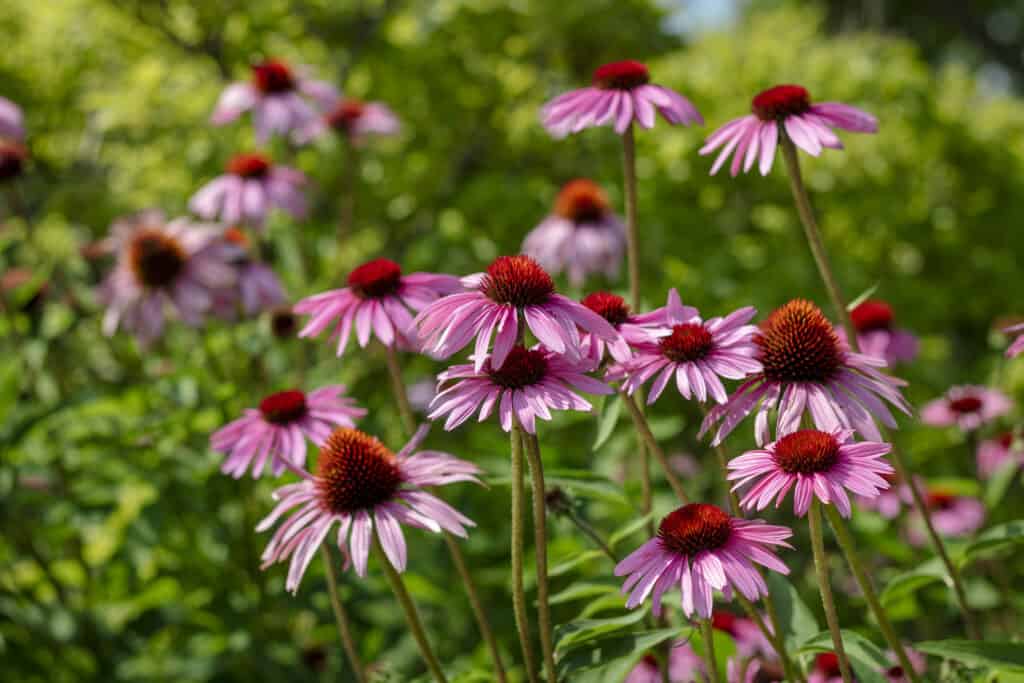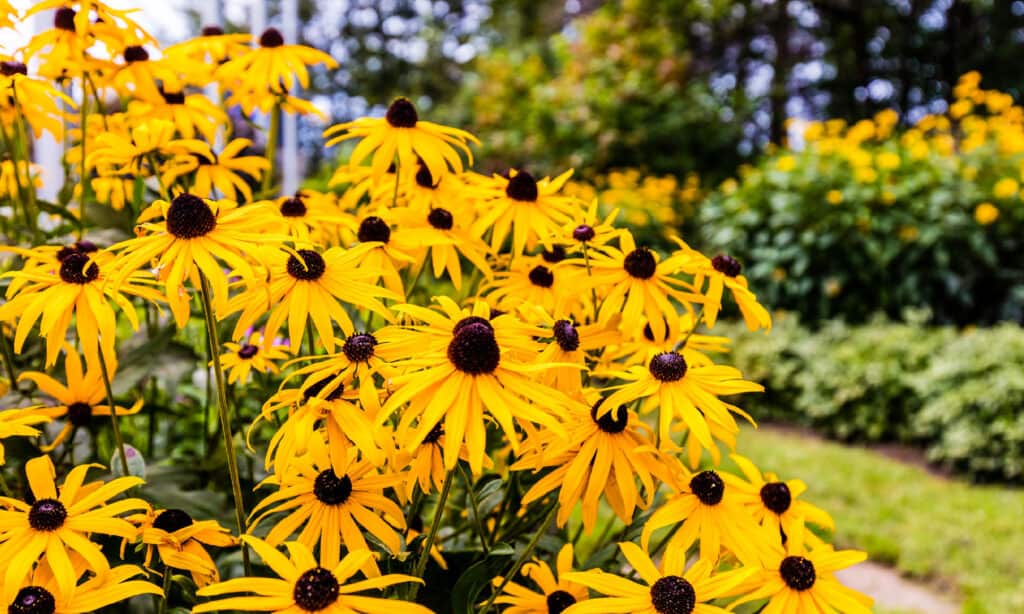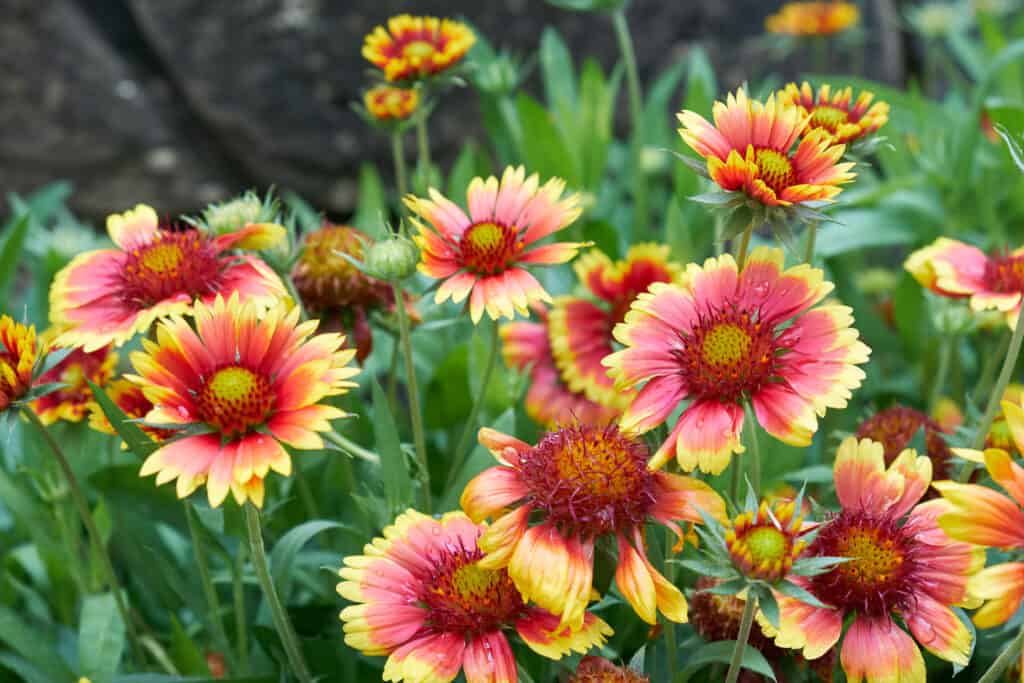Perennials are plants that live for more than two years. Full sun perennial flowers prefer direct sunlight for most of the day. Some common full sun perennials include coneflowers, black-eyed Susans, and coreopsis.
Sun-loving perennials are easy to care for and provide color and interest to your garden for many years. What are the best ones for you? Read on to learn about the best perennials for sunny spots!
1. Coneflowers

Coneflowers get their name from their characteristic cone-shaped center, which is surrounded by petals.
©iStock.com/Air Footy
Coneflowers are native North American wildflowers that gardeners all over the world adore. They’re one of the more unique full sun perennial flowers, and there are many of them. There are several species of echinacea. The most popular (and most accessible to grow) is echinacea purpurea; it’s chock full of antioxidants.
Coneflowers get their name from their characteristic cone-shaped center, which is surrounded by petals. The petals can be pink, purple, or white, and they are often marked with dark spots. Coneflowers are easy to care for and make an excellent addition to any garden. They are tolerant of poor soil and drought, and they will bloom from early summer until fall.
To ensure that your cone flowers thrive, make sure to plant them in a sunny location with well-drained soil. With just a little bit of care, these beautiful flowers will bring color and life to your garden for many years to come. Pro-tip; when planting full sun perennials, be sure to choose a spot that gets at least six hours of direct sunlight each day. These plants also need well-drained soil and need water regularly during the growing season. With a little care, full sun perennials will thrive in your garden for many years to come.
2. Black-eyed Susans

Black-eyed Susans typically grow to a height of 2-3 feet, producing an abundance of flowers from early summer to fall.
©iStock.com/Dopeyden
Black-eyed Susans (Rudbeckia hirta) are a common sight in gardens and meadows across North America. These hardy plants are easy to grow and maintain, and they add a splash of color to any landscape. Black-eyed Susans are members of the Aster family, and they get their name from their distinctive black center. The outer petals are usually yellow or gold, and the blooms measure 1-2 inches in diameter.
The plants typically grow to a height of 2-3 feet, producing an abundance of flowers from early summer to fall. Black-eyed Susans are very tolerant of poor soil conditions. While they are full sun perennial flowers, they can thrive in partial shade. If you are looking for a plant that is unique and common, consider planting Black-eyed Susans. You’ll enjoy watching butterflies dance among the blooms. It’s a sight to see!
3. Coreopsis Lanceolata

Coreopsis lanceolata is easy to grow and maintain, and it produces cheerful blooms from spring to fall.
©iStock.com/dianaarturovna
Coreopsis lanceolata, commonly known as lanceleaf coreopsis or tickseed, is a popular choice for sunny gardens. This perennial flower is easy to grow and maintain, and it produces cheerful blooms from spring to fall. If you’re thinking about adding coreopsis to your garden, here’s what you need to know.
Lanceleaf coreopsis is a member of the aster family. It is native to North America, and it grows in woods, meadows, and prairies from Canada to Florida. The plant grows to a height of 2-3 feet and has a spreading habit. The leaves are lance-shaped or oblong and have serrated edges.
The flowers are daisy-like, with yellow petals and brownish-red centers. Coreopsis lanceolata is an annual or short-lived perennial, meaning that it will bloom for one season and then die back in winter. However, it often reseeds itself, so you may find new plants popping up in spring.
If you’re looking for a hardy, simple-to-care-for option, lanceleaf coreopsis is a great choice. It is tolerant of a wide range of soils and grows best in full sun. Once established, the plant is quite drought-resistant. Coreopsis lanceolata is also relatively resistant to pests and diseases.
The only pests you’ll have to worry about are Japanese beetles, which may feed on the leaves. To keep them at bay, try planting lanceleaf coreopsis alongside marigolds or zinnias. This helps protect the plants and discourages the beetles from feeding. You can also handpick the beetles off of the plants or trap them using a Japanese beetle trap.
4. Shasta Daisies

Shasta daisies feature large, showy blooms in a variety of colors.
©iStock.com/ChristySturm
Shasta daisies are one of the most popular flowers in home gardens. These hardy perennials feature large, showy blooms in a variety of colors. While they are relatively easy to grow, correctly identifying Shasta daisies can be a bit tricky. Here are a few tips to help you out.
One of the easiest ways to identify Shasta daisies is by their flowers. The blooms typically measure 3-4 inches across and have white petals with a yellow center. Another distinctive feature is the long, pointed leaves. Shasta daisies also tend to be quite tall, growing anywhere from 2-3 feet in height.
When it comes to planting, Shasta daisies are pretty versatile. They can thrive in both sun and partial shade and will thrive in a wide range of soil types. However, they do prefer moist conditions and will need water regularly during hot, dry periods.
With a little care, Shasta daisies will bloom from early summer all the way through fall. When you’re looking for a perennial that will spice up your garden for months, add some Shasta daisies to your shopping list!
5. Blanket Flowers

Blanket flowers prefer full sun and well-drained soil.
©iStock.com/Iseo Yang
Last, on our list of full sun perennial flowers, let’s talk about a great ground cover option. Blanket flowers (Gaillardia x Grandiflora) are a beautiful addition to any garden, with their unique daisy-like blooms in shades of red, orange, and yellow. These hardy perennials are relatively easy to care for, and they will bloom from early summer right through to fall.
How can you identify blanket flowers in the wild? The blooms of Gaillardia x Grandiflora are roughly 3-4 inches in diameter, with a bright yellow center and petals that are red or orange at the tips. The leaves of this plant are long and narrow, with a pointed tip. They are typically green in color, but some varieties may have bronze or purple tints.
Blanket flowers prefer full sun and well-drained soil. If you live in an area with hot summers, they will appreciate a little afternoon shade.
Up Next:
- Calendula vs Marigold: Is There a Difference?
- What Plants Keep Copperhead Snakes Away?
- 7 Full Sun Annual Flowers
The photo featured at the top of this post is © iStock.com/Jasmina81
Sources
- The Backyard Garden Lover, Available here: https://www.backyardgardenlover.com/sun-loving-perennials-that-bloom-all-summer/
- Julie Martens Forney, Available here: https://www.hgtv.com/outdoors/flowers-and-plants/13-perennials-for-full-sun-pictures
- Arricca Sansone, Available here: https://www.countryliving.com/gardening/garden-ideas/g24942296/full-sun-perennials/
Thank you for reading! Have some feedback for us? Contact the AZ Animals editorial team.






